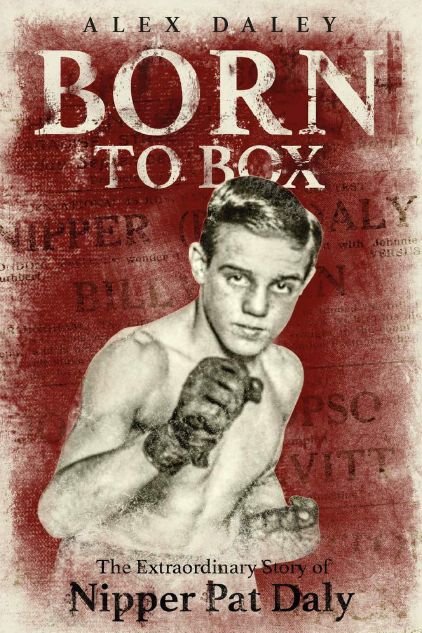NIPPER PAT DALY – A PRO AT AGE OF TEN!
Book review by Patrick Myler
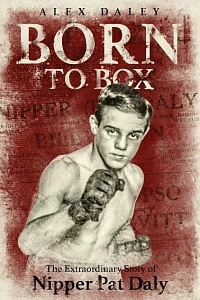 Talk about sending a boy to do a man’s job. Pat Daly was aged ten – yes, that’s right, ten – when he had his first professional fight.
Talk about sending a boy to do a man’s job. Pat Daly was aged ten – yes, that’s right, ten – when he had his first professional fight.
When most kids of that age were out playing marbles, climbing trees or swiping apples from orchards, Daly (born Patrick Daley) was spending hours in the gym learning his job and taking fights in the noisy, smoke-filled halls that proliferated London in the 1920s.
With his exceptional talent, by the age of 14 he was beating grown men in gruelling 15-round fights. By 16, he had beaten several British champions and was ranked by The Ring in the world’s top ten.
Ruled too young throughout his eight-year career to fight for a title, he was recklessly overworked and was burned out by the aged of 17. He called it quits in 1931 with a record of 99 wins, 11 losses, eight draws and one no-contest.
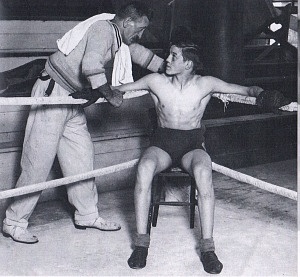 In Born to Box: the Extraordinary Story of Nipper Pat Daly, his grandson, Alex Daley, has done a commendable job in chronicling the remarkable life and ring career of a gifted gloveman whose name will not mean much to most boxing fans, especially those outside the British Isles, but who earns his place in ring history as probably the youngest ever to fight for pay.
In Born to Box: the Extraordinary Story of Nipper Pat Daly, his grandson, Alex Daley, has done a commendable job in chronicling the remarkable life and ring career of a gifted gloveman whose name will not mean much to most boxing fans, especially those outside the British Isles, but who earns his place in ring history as probably the youngest ever to fight for pay.
The author, who draws on his grandfather’s unpublished memoirs, does not pull his punches on who was to blame for throwing “Nipper” (the nickname simply means “boy”) into the bearpit with older, seasoned campaigners. That was his manager/trainer Andy Newton.
A former British amateur champion whose deep knowledge of the game earned him the nickname “Professor”, though he was barely literate, Newton was so impressed with nine-year-old Daly’s first sparring match in the gym that he immediately saw his championship potential.
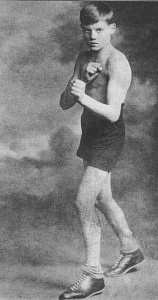 Right from the start, Newton shamefully exploited the kid’s talent. The boy’s father agreed to pay Newton 30 shillings for three months’ training and had to concede that any purse money up to the age of 14 would go to the “professor”.
Right from the start, Newton shamefully exploited the kid’s talent. The boy’s father agreed to pay Newton 30 shillings for three months’ training and had to concede that any purse money up to the age of 14 would go to the “professor”.
By the time he got around to taking home some belated pocket money, he was already topping the bill at leading venues, such as Premierland in Whitechapel, against much older opponents. In 1928, he fought 25 times, losing just twice. The following year he climbed between the ropes 33 times, winning 29, drawing one and being kayoed three times.
When criticised for matching the youngster too tough, the “professor” responded: “The boy thrives on hard work. Anyway, resting boxers makes them rusty.”
One of Daly’s wins in 1928 was over Bert Kirby, leading contender for the British flyweight title. That earned him an overweight match against the champion, Johnny Hill, but Pat, growing rapidly, decided he would move up to bantamweight.
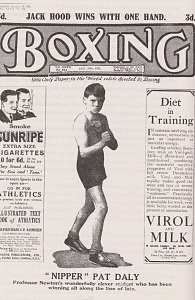 The following year he took the scalps of future European champion Nicholas Petit-Biquet, future British champion Dick Corbett and climbed up from a heavy knockdown to outscore former British champion Alf ‘Kid’ Pattenden.
The following year he took the scalps of future European champion Nicholas Petit-Biquet, future British champion Dick Corbett and climbed up from a heavy knockdown to outscore former British champion Alf ‘Kid’ Pattenden.
Still, despite being allowed to fight gruelling 15-round bouts week after week, the British Boxing Board of Control set the age limit for title contestants at 21.
Reports of the “boy wonder” had spread to the United States, with newspapers comparing his ability to the great Jimmy Wilde. The Montana Standard commented; “Daly has a born ability to land punches from every conceivable angle, especially at close quarters, and his speed is amazing. Recently he has shown himself possessed of a flashing right hand punch, which has put a number of opponents to sleep, but whether he has the knockout blow of a world’s champion only time can show.”
But “Professor” Newton, wary of losing control of his meal-ticket, expressed no interest in showing him to Americans and also turned down an offer for him to fight in Australia.
By the age of 17, it was clear that the years of hard fighting had taken a heavy toll and, after taking a bad beating from Seaman Tommy Watson, who two years later would challenge Kid Chocolate for the world featherweight title, Daly accepted that he was a spent force.
Finally prised from the vice-like control of “Professor” Newton, he took a three-month break before resuming his career. But, despite notching up seven wins against inferior opposition, he knew he could never recapture his old form and hung up his gloves in 1931 after opponent Harry Jenkins retired with a broken nose. The bout took place three weeks before Pat’s 18th birthday.
After a short spell as an all-in wrestler, Daly tried his hand at various roles, including owning a dancehall, delivering parcels for the post office and a stint as a plumber’s mate. He settled into a cleaning job at the Daily Mirror, then the most read newspaper in Britain, and enjoyed regular chats with the paper’s star sports writer Peter Wilson.
In his later years, his health declined and a brain scan revealed he had Alzheimer’s disease. While he still had his memory, he said in a newspaper interview that if he had his time over, he wouldn’t even have started serious boxing until he reached 18.
“I loved to fight,” he said. “I would say to myself, ‘If I can do this at 16, what will I be able to do when I’m 26’. They never allowed me to grow up naturally. In those days I looked like a matchstick. If I had been allowed to grow naturally I think I might have ended up as a light-heavyweight.”
Nipper Pat Daly died on 25 September 1988, aged 75.
Alex Daley, who writes a popular “Yesterday’s Heroes” column for the British weekly, Boxing News, has written an affectionate and totally absorbing account of his remarkable grandfather. “Born to Box: the Extraordinary Story of Nipper Pat Daly” is published by Pitch Publishing, of Worthing, Sussex, England. Hardback, it is priced at £19.99 (UK). It is also available on Amazon.Com
Patrick Myler is an author and boxing historian. He is a member of the IBRO and is on the election panel of the International Boxing Hall of Fame. He lives in Dublin, Ireland.
